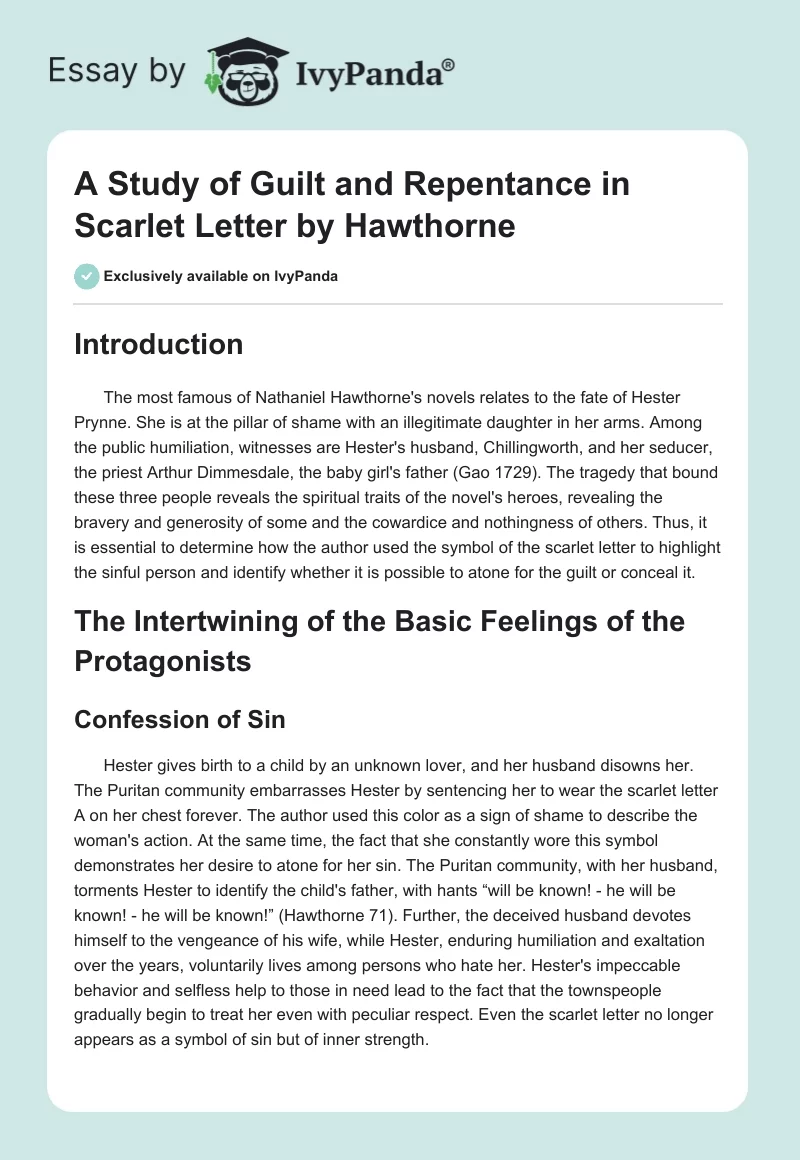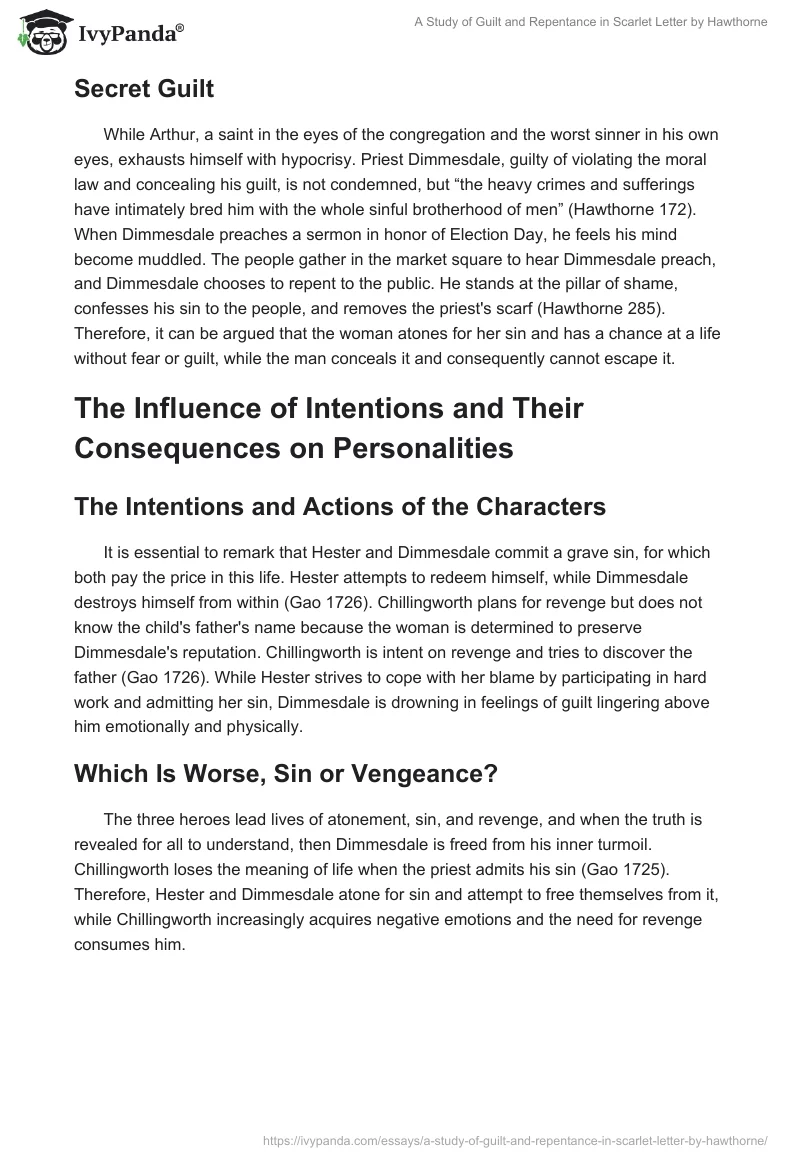Introduction
The most famous of Nathaniel Hawthorne’s novels relates to the fate of Hester Prynne. She is at the pillar of shame with an illegitimate daughter in her arms. Among the public humiliation, witnesses are Hester’s husband, Chillingworth, and her seducer, the priest Arthur Dimmesdale, the baby girl’s father (Gao 1729). The tragedy that bound these three people reveals the spiritual traits of the novel’s heroes, revealing the bravery and generosity of some and the cowardice and nothingness of others. Thus, it is essential to determine how the author used the symbol of the scarlet letter to highlight the sinful person and identify whether it is possible to atone for the guilt or conceal it.
The Intertwining of the Basic Feelings of the Protagonists
Confession of Sin
Hester gives birth to a child by an unknown lover, and her husband disowns her. The Puritan community embarrasses Hester by sentencing her to wear the scarlet letter A on her chest forever. The author used this color as a sign of shame to describe the woman’s action. At the same time, the fact that she constantly wore this symbol demonstrates her desire to atone for her sin. The Puritan community, with her husband, torments Hester to identify the child’s father, with hants “will be known! – he will be known! – he will be known!” (Hawthorne 71). Further, the deceived husband devotes himself to the vengeance of his wife, while Hester, enduring humiliation and exaltation over the years, voluntarily lives among persons who hate her. Hester’s impeccable behavior and selfless help to those in need lead to the fact that the townspeople gradually begin to treat her even with peculiar respect. Even the scarlet letter no longer appears as a symbol of sin but of inner strength.
Secret Guilt
While Arthur, a saint in the eyes of the congregation and the worst sinner in his own eyes, exhausts himself with hypocrisy. Priest Dimmesdale, guilty of violating the moral law and concealing his guilt, is not condemned, but “the heavy crimes and sufferings have intimately bred him with the whole sinful brotherhood of men” (Hawthorne 172). When Dimmesdale preaches a sermon in honor of Election Day, he feels his mind become muddled. The people gather in the market square to hear Dimmesdale preach, and Dimmesdale chooses to repent to the public. He stands at the pillar of shame, confesses his sin to the people, and removes the priest’s scarf (Hawthorne 285). Therefore, it can be argued that the woman atones for her sin and has a chance at a life without fear or guilt, while the man conceals it and consequently cannot escape it.
The Influence of Intentions and Their Consequences on Personalities
The Intentions and Actions of the Characters
It is essential to remark that Hester and Dimmesdale commit a grave sin, for which both pay the price in this life. Hester attempts to redeem himself, while Dimmesdale destroys himself from within (Gao 1726). Chillingworth plans for revenge but does not know the child’s father’s name because the woman is determined to preserve Dimmesdale’s reputation. Chillingworth is intent on revenge and tries to discover the father (Gao 1726). While Hester strives to cope with her blame by participating in hard work and admitting her sin, Dimmesdale is drowning in feelings of guilt lingering above him emotionally and physically.
Which Is Worse, Sin or Vengeance?
The three heroes lead lives of atonement, sin, and revenge, and when the truth is revealed for all to understand, then Dimmesdale is freed from his inner turmoil. Chillingworth loses the meaning of life when the priest admits his sin (Gao 1725). Therefore, Hester and Dimmesdale atone for sin and attempt to free themselves from it, while Chillingworth increasingly acquires negative emotions and the need for revenge consumes him.
Freedom from the Burden of Guilt
Guilt as One of the Symbols of Christianity
The novel is filled with Christian virtue despite committing a grave sin. Hester’s refusal to name her daughter’s father protects him from public humiliation and burdens his conscience until he openly confesses. Even though Chillingworth had no part in Hester and Dimmesdale’s sin, Chillingworth feels a desire for revenge. This is not a Christian virtue, and it gradually destroys him (Luke 23.41). At the same time, Dimmesdale is freed from his guilt by a sincere confession before an audience and the praise of God, while Hester “will redeem herself for the rest of her life” (Hawthorne 44). Accordingly, they choose Christian methods to save their souls, while Chillingworth, on the contrary, only piles on the hatred.
The Consequences of Heroes’ Decisions
After Dimmesdale’s death, Chillingworth, who had lost the meaning of life, immediately becomes weak. Not a year later, he dies, and he bequeaths his entire vast fortune to little Pearl. After his death, Hester and her daughter Pearl disappear, and many years later, Hester returns and voluntarily wears the emblem of the sight again. A woman can live and atone for her guilt because “she had not known the weight, until she felt the freedom” (Hawthorne 250). Pearl is happily married but constantly remembers her mother, writing to her and sending her gifts (Hawthorne 321). Hester wants to live where she is a sinner to atone for her sin.
Conclusion
Therefore, sins cannot be hidden from God; the only method of forgiveness is to repent sincerely. However, concealing sin leads to a torment of conscience, which later results in a confession of guilt, but there may no longer be time for atonement. It is significant to note that the worst feeling in the novel is hatred and revenge, which only escalates and cannot be dispensed with without sincere forgiveness of the actions of others.
Works Cited
Gao, Haihong. “An Analysis of Symbolic Images in The Scarlet Letter.” Theory and Practice in Language Studies, vol. 8, no. 1, 2018, pp. 1725-1731.
Hawthorne, Nathaniel. The Scarlet Letter: 1850. Infomotions, Incorporated, 1850.
The Bible. Authorized King James Version, Cambridge UP, 2004.


